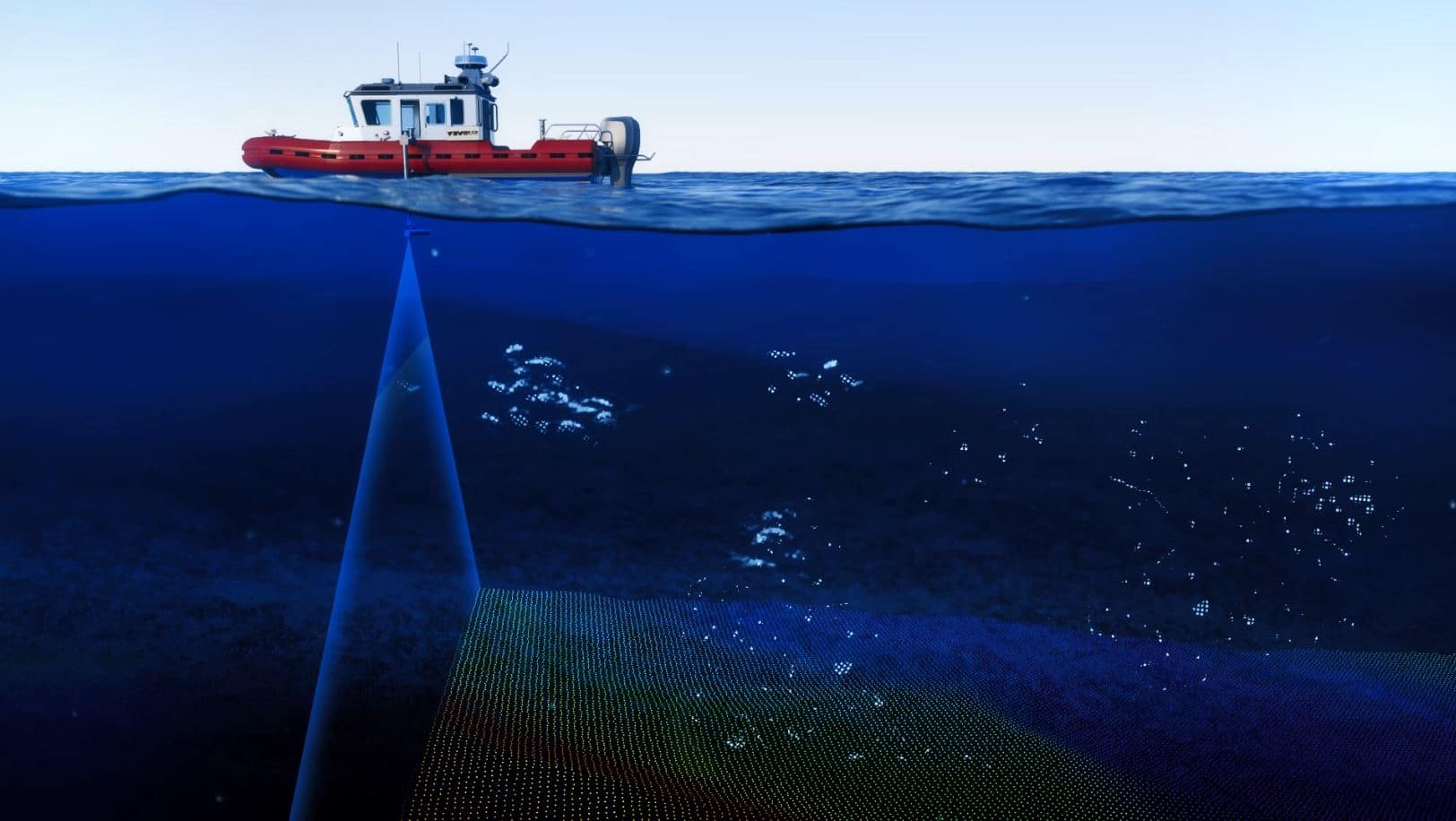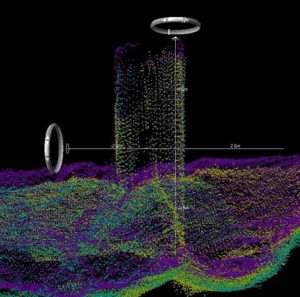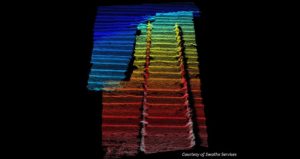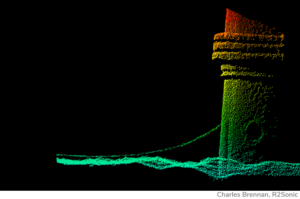Multibeam echosounders are defined by technical features that are specific to acoustic devices. Some of the technical terms may not initially be intuitive even to surveyors.
The objective of this document is to define each technical term to help you understand the importance and implication of each of those concepts in the context of a hydrographic survey.
| Technical Terms in Spec Sheet | What is it? | Implication and Value for a Hydrographic Survey |
|---|---|---|
| Selectable Frequencies | Range of frequencies from which you can select the most appropriate operating frequency for your survey. | The greater the range of frequencies, the greater the ability to select the most optimum frequency for the survey conditions. Having access to very low frequencies (90kHz or 100kHz) allows you to survey to depths of 600 to 700 metres, or deeper. Surveying at very high frequencies (700kHz) allows you to collect ultra high resolution data thanks to greater acoustic resolution (vertical resolution) and smaller beamwidth (horizontal resolution). |
| Minimum frequency change | Minimum change, in frequency, within a range of selectable frequencies. | The ability to change the frequency, in small steps (1Hz) provides a larger number of options and therefore greater flexibility, which enables the surveyor to select the optimum frequency for the survey conditions. |
| Beamwidth, across track and long track | It is the measure of the footprint. | The smaller the beamwidth (or footprint), the greater the resolution. Indeed, the sounding reported by each beam is calculated as the average of the area ensonified by each beam and therefore, the smaller the area, the more truthful and accurate is the average calculated. It provides more granular information. |
| Number of soundings | Number of datapoints reported from the bottom and/or water column. | Resolution improves as the number of independent soundings increases. However, increasing the number of soundings if they overlap does not help improve resolution. The more independent the soundings, the cleaner the data and therefore the easier and faster it is to process the data. Increasing the number of independent soundings is specially critical when surveying detailed structures. The Ultra High Density (UHD) mode returns 1024 independent soundings per ping providing a four times increase in sounding resolution. |
| Max speed (vessel) | Maximum speed recommended to ensure full coverage. | The maximum speed of survey to ensure full coverage depends on: - characteristics that are defined by the multibeam echosounder such as the ping rate - the environment in which the survey is performed, such as the water depth - the installation of the multibeam echosounder and other sensors |
| Near-field focusing | Ability to ensure high resolution commensurate with beamwidth. | All multibeam echosounders are characterized by a near-field region and a far-field region. In the near-field region, the unfocused spatial resolution is the same as the length of the array (transducer). As a result, unless the multibeam echosounder is equipped with near-field focusing, there is poor resolution in the near-field which can have an impact when surveying in shallow waters. Good resolution is obtained in the near-field by dynamically focusing the beams. |
| Roll stabilized beams | Ability to compensate for the roll motion of the vessel. | When the vessel moves from side to side (port to starboard), it impacts the coverage and the density of soundings. Multibeam echosounders equipped with roll stabilization capabilities account for the roll motion in their calculation, making the corresponding correction to ensure accurate report of the location of the target |
| Pitch stabilized beams | Ability to compensate for the pitch motion of the vessel. | Pitch refers to the up-or-down motion of the bow and stern of the vessel. This movement has an impact on the area ensonified and therefore on the along-track density of soundings. It is particularly relevant in waters deeper than 300m. Multibeam sonars equipped with pitch stabilization capabilities steer the transmit pulse to compensate for the pitch motion. |
| ROBO™ automated operation | It automates the parameters of the multibeam sonar. | When the ROBO™ mode is enabled, the mode calculates the operating parameters based on the range setting. However, the automated operation presents limitations if the conditions of the survey change and/or if the characteristics of the area surveyed change outside of the limits of the mode. The ROBO™ mode can be useful, but it is imperative to monitor the data collected by the sonar and adjust the settings if necessary. |
| Saturation monitor | Available in the Graphic User Interface (GUI) that helps the surveyor adjust the gain and power to ensure optimum survey results. | The Saturation Monitor shows the degree of receiver saturation, or how much the receivers are being driven by the returning acoustic energy. The saturation monitor helps the surveyor adjust the operating parameters (power, amplitude, pulse length, absorption, etc.) so that the receiver operates in a linear manner (below 100% saturation). It helps the surveyor tune the sonar so that power and gain are optimized for the survey area. |
| Selectable Swath Sector (also called Max coverage) | Ability to adjust the swath sector by changing its width and/or angle. | A wider swath helps survey a larger area in a shorter period of time, at the expense of resolution, specially for the outer beams. The wider the swath sector, the larger the footprint of each beam and therefore the lower the resolution. A narrower swath ensures higher density of soundings and greater resolution on the outer beams, but requires more survey lines to cover the same area. Also, since the beamwidth is smaller with a narrow swath sector, it will result in smaller shadows, specially on the outer beams. In areas with depressions, it is recommended to reduce the swath sector to ensure full coverage. Adjusting the angle of the swath sector, allows the surveyor to switch from ensonifying the area right below the multibeam sonar to horizontal areas. This is useful when surveying vertical structures. |
| Sounding Patterns | This refers to the geometry of the soundings reported. - Equiangular means that each sounding is reported as the center of each beam and that soundings are spaced with equal angle. Therefore, the density of datapoints is greater at nadir than for the outer beams on a flat bottom - Equidistant means that all soundings are at the same distance from one another on a flat bottom and therefore that the across-track density is the same - Quad mode which provides a better distribution of soundings along track - Ultra High Density (UHD) is R2Sonic proprietary method that increases the sounding density to 1024 independent datapoints | It is worth highlighting: - The Quad mode provides a better distribution of the soundings along track, so that the returns from a specific beam, are not on the same along-track line. This allows for better coverage. - As mentioned, above, the UHD mode, provides up to 1024 independent soundings per ping |
| Sounding Depth | Based on previous surveys, it is the maximum water depth at which the multibeam echosounder can survey. | A multibeam echosounder does not measure depth; it measures a range and a bearing to points on the seafloor. Depth is computed within the data collection software using the range and bearing data from the multibeam sonar. The installation of the multibeam echosounder and the bottom composition significantly influences the depth sounding capabilities. The water temperature and salinity also have a significant impact on the sounding depth capabilities. |
| Pulse Length | The multibeam echosounder continuously sends short acoustic signals in the water, called pings. Each ping is defined by its amplitude and length, which is the time during which the acoustic signal is sent. | The shorter the pulse length, the greater the vertical resolution, as it provides the ability to distinguish two targets that are close to each other. Surveying with short pulse length is possible with high performing multibeam echosounders that rely on optimized and "well orchestrated" electronics that generate little-to-no noise that interferes with the echo reflected on the targets and received by the sonar. |
| Pulse Type | It's the type of modulation used to send the acoustic signal in the water. | Different multibeam echosounders use different types of modulation to transmit the acoustic signal into the water. Shaped CW (Continuous Wave) is a single frequency sinusoidal wave. Typically it is a high-power signal that is relatively short in duration (burst). FM (Frequency Modulated) waveform is a sinusoidal signal that increases or decreases in frequency over time and at a constant rate. FM signals are longer in duration which can compromise bottom coverage in shallow water. Also, longer pulses have "side effects" that can compromise the accuracy of the data reported. These are: - Doppler Effect - Temporal Side lobes Multibeam sonars operate in harsh conditions, with a lot of interference generated in the environment. In order to overcome this, multibeam echosounders with suboptimal electronics will be more likely to use longer pulse type so that even with a poor Signal to Noise Ratio (SNR), the multibeam sonar can detect the echo. High performing multibeam echosounders are known to be "quiet" in the sense that the electronics are optimized and don't generate noise. In this case, it is more likely that the multibeam sonar will rely on shorter pulse type (like CW) to ensure greater vertical resolution. |
| Ping rate | Number of pings sent in the water per second. | The Range setting sets the maximum slant range, and this sets the ping rate or how fast the sonar can transmit an acoustic pulse. By adjusting the range settings, the ping rate is automatically set. This value can only be decreased, understanding that a lower ping rate may have an impact on the coverage. Full coverage is dependent upon ping rate, survey speed and sounding depth. |
| Bandwidth | The bandwidth defines the range resolution. | The bandwidth is controlled by the pulse width. The shorter the pulse width, the higher the bandwidth, and the higher the resolution. At shorter pulse widths, the bandwidth is 60kHz. The bandwidth is a testament of the performance of the multibeam sonar. |
| Immersion Depth | Depth at which the multibeam sonar can be immersed. | 4000m and 6000m depth rated systems are used on AUV and ROV. |
| Bottom Detect Resolution | Resolution with which the multibeam echosounder detects the bottom (vertical resolution). | If the bottom detect resolution is 3mm, it means that the multibeam echosounder will detect the bottom with a margin of ±1.5mm. |




